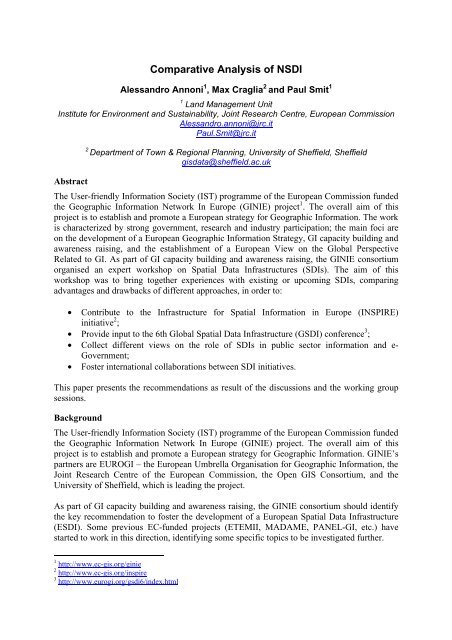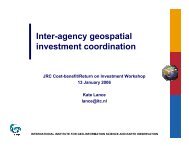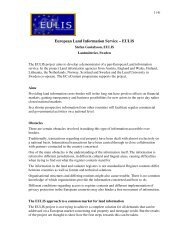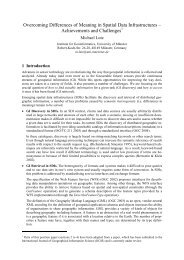Comparative Analysis of NSDI - EC GI & GIS Portal
Comparative Analysis of NSDI - EC GI & GIS Portal
Comparative Analysis of NSDI - EC GI & GIS Portal
You also want an ePaper? Increase the reach of your titles
YUMPU automatically turns print PDFs into web optimized ePapers that Google loves.
<strong>Comparative</strong> <strong>Analysis</strong> <strong>of</strong> <strong>NSDI</strong><br />
Alessandro Annoni 1 , Max Craglia 2 and Paul Smit 1<br />
1 Land Management Unit<br />
Institute for Environment and Sustainability, Joint Research Centre, European Commission<br />
Alessandro.annoni@jrc.it<br />
Paul.Smit@jrc.it<br />
Abstract<br />
2 Department <strong>of</strong> Town & Regional Planning, University <strong>of</strong> Sheffield, Sheffield<br />
gisdata@sheffield.ac.uk<br />
The User-friendly Information Society (IST) programme <strong>of</strong> the European Commission funded<br />
the Geographic Information Network In Europe (<strong>GI</strong>NIE) project 1 . The overall aim <strong>of</strong> this<br />
project is to establish and promote a European strategy for Geographic Information. The work<br />
is characterized by strong government, research and industry participation; the main foci are<br />
on the development <strong>of</strong> a European Geographic Information Strategy, <strong>GI</strong> capacity building and<br />
awareness raising, and the establishment <strong>of</strong> a European View on the Global Perspective<br />
Related to <strong>GI</strong>. As part <strong>of</strong> <strong>GI</strong> capacity building and awareness raising, the <strong>GI</strong>NIE consortium<br />
organised an expert workshop on Spatial Data Infrastructures (SDIs). The aim <strong>of</strong> this<br />
workshop was to bring together experiences with existing or upcoming SDIs, comparing<br />
advantages and drawbacks <strong>of</strong> different approaches, in order to:<br />
• Contribute to the Infrastructure for Spatial Information in Europe (INSPIRE)<br />
initiative 2 ;<br />
• Provide input to the 6th Global Spatial Data Infrastructure (GSDI) conference 3 ;<br />
• Collect different views on the role <strong>of</strong> SDIs in public sector information and e-<br />
Government;<br />
• Foster international collaborations between SDI initiatives.<br />
This paper presents the recommendations as result <strong>of</strong> the discussions and the working group<br />
sessions.<br />
Background<br />
The User-friendly Information Society (IST) programme <strong>of</strong> the European Commission funded<br />
the Geographic Information Network In Europe (<strong>GI</strong>NIE) project. The overall aim <strong>of</strong> this<br />
project is to establish and promote a European strategy for Geographic Information. <strong>GI</strong>NIE’s<br />
partners are EURO<strong>GI</strong> – the European Umbrella Organisation for Geographic Information, the<br />
Joint Research Centre <strong>of</strong> the European Commission, the Open <strong>GI</strong>S Consortium, and the<br />
University <strong>of</strong> Sheffield, which is leading the project.<br />
As part <strong>of</strong> <strong>GI</strong> capacity building and awareness raising, the <strong>GI</strong>NIE consortium should identify<br />
the key recommendation to foster the development <strong>of</strong> a European Spatial Data Infrastructure<br />
(ESDI). Some previous <strong>EC</strong>-funded projects (ETEMII, MADAME, PANEL-<strong>GI</strong>, etc.) have<br />
started to work in this direction, identifying some specific topics to be investigated further.<br />
1 http://www.ec-gis.org/ginie<br />
2 http://www.ec-gis.org/inspire<br />
3 http://www.eurogi.org/gsdi6/index.html
The term Spatial Data Infrastructure (SDI) is not perceived in the same way across Europe,<br />
and the importance given to invest in it is strictly connected to the level <strong>of</strong> awareness about<br />
the use and potential <strong>of</strong> spatial data (protecting the environment, increased security, better<br />
transport, socially just development, and enhanced services to citizens require decisionmakers<br />
to identify where need is most pressing, and the means to effectively target<br />
intervention, monitor outcomes, and assess impact,…).<br />
The term SDI encapsulates the necessary framework <strong>of</strong> policies, institutional arrangements,<br />
technologies, data, and people that makes it possible to share and effectively use geographic<br />
information.<br />
The importance <strong>of</strong> an SDI for good governance, economic, and social development, has lead<br />
most countries in the world to engage in the process <strong>of</strong> developing such infrastructures. A<br />
survey 4 completed in December 2001, indicates that 120 <strong>of</strong> the 192 nations in the world are<br />
working on their national spatial data infrastructure, with half having already established<br />
catalogues <strong>of</strong> key data resources searchable on the Web. Whilst there is clearly a lot <strong>of</strong><br />
variability on the extent and quality <strong>of</strong> such endeavours, this finding indicates that SDIs are<br />
not just a luxury <strong>of</strong> wealthy nations, but a perceived strategic development for both developed<br />
and developing countries.<br />
A European Spatial Data Infrastructure<br />
In Europe, most countries are in the process <strong>of</strong> developing SDIs at national and/or<br />
regional/local levels. There are world-class examples <strong>of</strong> best practice, side by side with very<br />
patchy developments that have only recently started to make some visible progress. These<br />
variations are partly a function <strong>of</strong> the institutional and cultural heterogeneity <strong>of</strong> Europe, but<br />
also <strong>of</strong> the varying levels <strong>of</strong> awareness and political support that exist across the continent. As<br />
Europe becomes economically and socially more integrated, there is also a growing<br />
recognition that some <strong>of</strong> the processes that need to be addressed at a Europe-wide scale, such<br />
as environmental change, security, transport, and social cohesion, require Europe-wide<br />
frameworks <strong>of</strong> spatial data with at least some minimum common denominator across all<br />
countries.<br />
With this in mind, a recent major initiative has been launched by the European Commission to<br />
develop an Infrastructure for Spatial Information in Europe (INSPIRE). The vision <strong>of</strong> this<br />
initiative, which is the first step towards a European SDI, is:<br />
• Data should be collected once and maintained where this can be done most effectively.<br />
• It must be possible to combine seamlessly spatial information from different sources<br />
across Europe and share it between many users and applications.<br />
• It must be possible for information collected at one level to be shared between all the<br />
different levels, e.g. detailed for detailed investigations, general for strategic purposes.<br />
• Geographic information needed for good governance at all levels should exist and be<br />
available widely under conditions that do not inhibit its extensive use.<br />
• It must be easy to discover which geographic information is available, fits the needs for<br />
a particular use and under what conditions it can be acquired and used.<br />
• Geographic data must be easy to understand and interpret within the appropriate context<br />
and selected in a user-friendly way through the use <strong>of</strong> visualization tools.<br />
4 Crompvoets, J. and Bregt, A. 2002. World Status <strong>of</strong> National Spatial Data Clearinghouses,<br />
http://www.urisa.org/Journal/Under_Review/articles_under_review.htm
Whilst INSPIRE aims to develop a legal framework to underpin the creation <strong>of</strong> a European<br />
SDI starting from priorities in the environmental field, it is clearly important to evaluate the<br />
extent <strong>of</strong> progress <strong>of</strong> SDIs in Europe, and identify key issues that need addressing to ensure<br />
complementarity between European and national/regional developments.<br />
Some <strong>of</strong> the hypothetical principles/expectations <strong>of</strong> European citizens can be summarized as:<br />
• Europe desires common spatial data (e.g., foundation, reference, core) organized<br />
according to standard types and accepted scales, that need to be widely available for<br />
all <strong>of</strong> Europe at the administrative, neighbourhood, city, state, nation and Europeanwide<br />
levels to which other geospatial data can be easily referenced.<br />
• It is believed essential that common spatial data (whether it be a representation <strong>of</strong> that<br />
data or the data itself) be portable, and made readily accessible and available to any<br />
one, at some defined cost, from user-friendly and seamless sources to meet public<br />
need and encourage conformance by producers <strong>of</strong> other geospatial information.<br />
• It is believed essential that both common and other geospatial data be updated<br />
according to commonly established practices, standards and measures <strong>of</strong> quality.<br />
• It is believed that thematic and tabular data be made easily accessible on terms not<br />
incompatible with common data.<br />
• It is believed essential that common and other geospatial data produced by one<br />
organization, political jurisdiction or nation is compatible with similar data produced<br />
by other organizations, political jurisdictions or nations.<br />
• It is believed essential that all geospatial data be capable <strong>of</strong> being integrated with<br />
many other kinds or sets <strong>of</strong> data to produce information useful to decision makers and<br />
the public.<br />
• It is believed that the responsibility for generating, maintaining and distributing<br />
common data is shared by organizations, political jurisdictions or nations and that<br />
Governments at all levels should take advantage <strong>of</strong> private sector capabilities at<br />
competitive prices rather than maintaining dedicated capabilities.<br />
• It is believed that the value <strong>of</strong> common data can only be recognized by government<br />
legislative bodies when the costs <strong>of</strong> generating, maintaining and distributing any<br />
geospatial data are justified in terms <strong>of</strong> public benefit and/or private gains, and there is<br />
a present and future value savings from reducing overlap and duplication among<br />
participating organizations.<br />
• It is believed essential that Europe acknowledge that SDIs are designed top down, but<br />
built bottom up. Taking on the credo "think globally and act locally" is a call that<br />
Europe understands. Having processes in place that account for two-way flows <strong>of</strong><br />
influence are critical.<br />
For the purpose <strong>of</strong> evaluating the extent <strong>of</strong> progress <strong>of</strong> SDIs in Europe, and identifying key<br />
issues that need to be addressed, <strong>GI</strong>NIE convened a meeting <strong>of</strong> experts in the field <strong>of</strong> SDIs,<br />
coming from 13 European countries and the US. The meeting took place at the Joint Research<br />
Centre <strong>of</strong> the European Commission in Ispra, Italy, 6-8 th May 2002.<br />
All aspects <strong>of</strong> SDI implementation were touched upon:<br />
Organizational and fundamental aspects<br />
- Foundation<br />
- Standards<br />
- Legal framework
- Funding<br />
- Roles and responsibilities<br />
- Intellectual property rights and pricing<br />
- Educational aspects<br />
Content<br />
- Core data<br />
- Semantic interoperability<br />
- Data documentation<br />
Access to information<br />
- Discovery services<br />
- Data access and geoprocessing services<br />
User expectations and benefit – objectives <strong>of</strong> the infrastructure<br />
- Driving applications<br />
- eGovernment, eEurope<br />
- Exploitation <strong>of</strong> public information<br />
The report evaluating the experiences <strong>of</strong> the individual countries represented at the meeting is<br />
available from the <strong>GI</strong>NIE Web site (www.ec-gis.org/ginie). Below is a summary <strong>of</strong> the key<br />
findings and recommendations.<br />
Summary <strong>of</strong> Findings<br />
What are the features <strong>of</strong> a successful SDI? An SDI is successful:<br />
• When it is developed, used, and maintained by several agencies responsible for key data<br />
resources including socio-economic, environmental, land and property, and reference<br />
data (e.g. addresses, administrative boundaries, physical infrastructure, and topographic<br />
features),<br />
• When it is ready to answer to real needs, particularly at times <strong>of</strong> emergency such as<br />
natural or man-made disasters,<br />
• When its framework data conform to common specifications, are maintained up-to-date,<br />
and are easy to find and access,<br />
• When it is multi-level from local to regional and national levels,<br />
• When there is functional homogeneity in the framework across levels <strong>of</strong> jurisdiction,<br />
• When there is clear authority in managing the framework,<br />
• When it supports sufficient economy to justify itself.<br />
Political Support<br />
If the characteristics highlighted above are those <strong>of</strong> a fully functional SDI, the experiences <strong>of</strong><br />
SDIs reviewed at the meeting showed that the more successful SDI, i.e. those coming closest<br />
to these characteristics, also enjoyed the highest and most consistent level <strong>of</strong> political support<br />
throughout their development. Conversely, the experiences that are patchier in geographical<br />
coverage, and more monothematic in content tend to have developed in a climate <strong>of</strong> more<br />
limited political support.
This <strong>of</strong> course does not come as a surprise but it is important to have it confirmed by a wide<br />
range <strong>of</strong> national and international experiences, some <strong>of</strong> which have more than 10 years <strong>of</strong><br />
development behind them. Two aspects are worth underlining:<br />
1. Political support at the highest level is crucial.<br />
This is because:<br />
• Most geographic information is collected, maintained, and used by public sector<br />
organisations, which are dependent on the policies set by government in respect to<br />
organisational priorities, funding, and regulatory mechanisms;<br />
• Geographic information is an expensive commodity, as well as underpinning a large<br />
number <strong>of</strong> government services to the citizen. It is therefore an area <strong>of</strong> tension<br />
between policies aimed at maximizing government revenue, and those, such as egovernment,<br />
aimed at maximizing benefits to citizens. Political support is therefore<br />
needed to resolve these conflicts.<br />
• SDIs are not primarily about technology, but about developing a clear framework <strong>of</strong><br />
agreements among government agencies, and between government, the private<br />
sector, and citizens on terms through which the use <strong>of</strong> public sector information,<br />
including geographic information, can be maximized for the benefits <strong>of</strong> all. These<br />
agreements <strong>of</strong>ten require attention and political support at the highest levels.<br />
• Governments therefore play an absolutely crucial role in the development <strong>of</strong> SDIs<br />
and <strong>of</strong> the Information Society because they are at the same time data producers,<br />
users, policy setters, and regulators who provide guidance to major public sector<br />
organizations.<br />
2. Political support needs to be sustained over time.<br />
By their very nature, political priorities may change due to external circumstances,<br />
change <strong>of</strong> administration, or even only change <strong>of</strong> key individuals. The experience <strong>of</strong><br />
some <strong>of</strong> the most well developed SDIs in the world indicates that even after many<br />
years <strong>of</strong> successful development they remain sensitive to changes in organisational<br />
priorities and political leadership.<br />
With these considerations in mind, it is clear that one <strong>of</strong> the absolute priorities for the<br />
development <strong>of</strong> an SDI is persistent action to gather and maintain support among political<br />
decision makers at all levels. Political support is needed to endorse and propagate the vision,<br />
establish the legal framework, and allocate resources to get results. This requires selling the<br />
benefits <strong>of</strong> SDIs throughout their development, without ever taking support for granted.<br />
Selling the Benefits<br />
An SDI can and should be developed at local, regional, national, European, and global levels.<br />
Therefore, there is a need to address politicians and decision-makers at each <strong>of</strong> these levels<br />
and demonstrate the benefits <strong>of</strong> having an SDI.<br />
The benefits have to address areas <strong>of</strong> high political priority such as crime reduction, health,<br />
education, spatial planning, environmental protection and disaster management. One must<br />
demonstrate how to support e-government and general economic development, reduce<br />
duplication and waste <strong>of</strong> resources, and increase competitiveness through the development <strong>of</strong><br />
new industries in the location-based services.<br />
To demonstrate such benefits it is possible at the beginning to use examples and cases from<br />
other parts <strong>of</strong> the world, suitably adapted to address local concerns, and as the local SDI
develops, it is important to focus on applications that can deliver quick wins, rather than<br />
spending a long time before showing any payback. At the European level, there are a number<br />
<strong>of</strong> key policy areas that can provide good case studies for the benefits <strong>of</strong> having an SDI, or<br />
conversely the costs <strong>of</strong> not having one. These include disaster management (for example, the<br />
Toulouse explosion or Chernobyl), environmental management (water framework directive,<br />
floods in Italy and along the Rhine basin), and transport (impact <strong>of</strong> blocked tunnels across the<br />
Alps).<br />
One <strong>of</strong> the important messages from the more successful SDI experiences is the need to<br />
manage expectations. The development <strong>of</strong> an SDI also requires education, and the change <strong>of</strong><br />
organisational cultures. These are <strong>of</strong>ten lengthy processes for many public sector<br />
organisations that have difficulty in adapting quickly to change. Some <strong>of</strong> the challenges that<br />
need facing include the need to work more horizontally across departments and agencies,<br />
having greater sensitivity to customer needs and requirements, and using information more<br />
effectively, as well as the ability to “let go” <strong>of</strong> “my” information. Selling the benefits has to<br />
be realistic and not based on hype.<br />
Coordination<br />
Coordination is one <strong>of</strong> the most important aspects in the development <strong>of</strong> an SDI, as indicated<br />
by the experience <strong>of</strong> all the countries analysed. Strong multi-agency coordinating frameworks<br />
characterize all the countries with the most developed national SDIs, such as the US and the<br />
Nordic states. Countries with the least developed national SDI, such as Spain, Belgium, and<br />
Austria, also have the weakest co-ordination at the national level. These countries have on the<br />
other hand excellent examples <strong>of</strong> regional SDIs because it is at that level that good<br />
coordinating mechanisms have developed. Coordination is therefore crucial.<br />
The roles <strong>of</strong> the coordinating body are manifold and include:<br />
• Leadership,<br />
• Mediating inter-agency conflicts,<br />
• Sustaining political support,<br />
• Selling the benefits to multiple audiences,<br />
• Providing technical guidance and enforcement <strong>of</strong> common standards,<br />
• Raising awareness and disseminating the results.<br />
In addition, coordination can also play a very useful role in identifying gaps or inconsistencies<br />
in the legal and organisational framework, and suggesting remedial action to the government.<br />
Whether a single organisation or more than one performs all <strong>of</strong> these activities; for example,<br />
one focusing on operational implementation, and another on strategic and legal issues, will<br />
depend on the circumstances. There is no question however that all <strong>of</strong> these activities are<br />
essential.<br />
This central activity for the life <strong>of</strong> an SDI does not need to be expensive or imply large<br />
bureaucracies. Using the US as an example, the Federal Geographic Data Committee<br />
(FGDC), which coordinates the National SDI, performs all <strong>of</strong> the functions above with a staff<br />
<strong>of</strong> 15 and a budget <strong>of</strong> $3.6 million per year, <strong>of</strong> which approximately half is spent as seed<br />
money to support the development <strong>of</strong> metadata and related services, and portals at federal,<br />
state and local level. This is therefore not a large structure or budget, but a very successful<br />
model, providing a high return on the investment made.
There are three other lessons from the US experience that are <strong>of</strong> particular relevance to<br />
Europe:<br />
• Even if political support comes from the highest possible level, without firm<br />
coordination the centripetal forces <strong>of</strong> each agency pulling in its own direction would<br />
undermine the SDI. Never underestimate “departmentalism”!<br />
• Coordination needs its own budget to be effective.<br />
• As with any complex project, there is a need to think big and act small, i.e. keep and<br />
promote the vision, but phase implementation.<br />
Phased Implementation<br />
The experiences <strong>of</strong> implementing SDIs in Europe clearly show that different models and<br />
approaches emerge as a result <strong>of</strong> the different cultural and institutional circumstances. Some<br />
countries spend longer in the planning stage, developing a coherent conceptual model <strong>of</strong> the<br />
SDI and its components before starting implementation; others are more pragmatic and start<br />
with whatever is already available and develop as they go along. One model does not fit all.<br />
Focusing on the endeavour <strong>of</strong> developing a European SDI, a phased implementation that<br />
builds and supports the existing national and regional SDIs is crucial. Collaboration and<br />
complementarity are key principles. At the same time, it is clear that national SDIs do not<br />
exist in every country. Therefore some legal backing requiring Member states <strong>of</strong> the EU to<br />
develop a base-line SDI seems necessary, whilst leaving the details <strong>of</strong> how this is undertaken<br />
to national responsibility.<br />
To support the development <strong>of</strong> national and regional SDIs, and their interoperability at the<br />
European level, there is a need to support organisational and institutional capacity, promote<br />
international standards and best practice, and provide technical coordination and support.<br />
Coordination and support should include the development <strong>of</strong> European specifications for data<br />
content based on what already exists, whilst keeping the impacts on national databases to a<br />
minimum.<br />
In addition to this foundation work there is also a need to harmonize the data layers and<br />
achieve seamless coherent information. The amount <strong>of</strong> work needed will vary on the layers<br />
and the level <strong>of</strong> agreement reached across the production chain on common definitions and<br />
standards. However, the existing experiences in Europe in relation to developing seamless<br />
data bases on soils, land cover, meteorological information, topography, and administrative<br />
boundaries indicates that significant harmonization work is needed, and that for each theme<br />
specific organisations need to be charged with the task <strong>of</strong> undertaking this work.<br />
Implementing an ESDI needs therefore to consider a series <strong>of</strong> issues including:<br />
• Identification and selection <strong>of</strong> who will be in charge <strong>of</strong> harmonizing the data layers,<br />
• Coordination <strong>of</strong> these organisations vis-à-vis the technical coordinators <strong>of</strong> the ESDI and<br />
existing European agencies,<br />
• How this work will be funded,<br />
• The relationships between original and harmonized data, issues <strong>of</strong> IPR and access.<br />
When building national and European SDIs, phased implementation is needed both from the<br />
top down (policy frameworks, coordination), and from the bottom up, integrating what<br />
already exists. It is crucial that the services implemented work together at each layer <strong>of</strong><br />
achievement, i.e. be interoperable.
In the European context (but this is equally valid at other levels) a Geo<strong>Portal</strong> is important for<br />
demonstration purposes, and to allow visualisation, processing and access to data. This<br />
service must be based on clear user needs, be multi-lingual to act as a European entry point to<br />
available services, and provide links to national portals based on service registers. To achieve<br />
this, existing catalogues in different countries need to be extended by building s<strong>of</strong>tware<br />
interfaces.<br />
The value <strong>of</strong> such a Geo<strong>Portal</strong> is to demonstrate what can already be achieved by making<br />
public sector data more visible and accessible, providing services that respond to user needs,<br />
and identifying priority areas for improvements and gaps to be filled. It also has the<br />
announcement value that something is happening, provides a measure <strong>of</strong> progress <strong>of</strong> SDI<br />
development through indicators such as the number <strong>of</strong> services and catalogues available over<br />
time, and measures user feedback.<br />
Summary <strong>of</strong> Recommendations<br />
To contribute to the development and implementation <strong>of</strong> a European Spatial Data<br />
Infrastructure (SDI), and support the INSPIRE initiative aimed at developing the legal<br />
framework for a ESDI, the expert group convened by <strong>GI</strong>NIE makes the following<br />
recommendations:<br />
1. Political sustainability<br />
It is recommended that politicians be encouraged to take an active role in all committees<br />
involved in establishing and steering the development <strong>of</strong> the SDI, at regional, national, and<br />
European levels.<br />
2. Financial sustainability<br />
To kick-start the establishment <strong>of</strong> a European SDI, it is recommended that financial<br />
support come initially from national governments through general taxation. These<br />
investments must be regarded as an integral part <strong>of</strong> the e-Europe and e-Government<br />
agendas because the SDI underpins the modernisation <strong>of</strong> government, and increased access<br />
to Public Sector Information. Once the initial infrastructure is in place, its long-term<br />
financial stability must be ensured. This may require a combination <strong>of</strong> public and private<br />
investment, and user charges congruent with the objective <strong>of</strong> maximising its use.<br />
3. Legal Framework<br />
It is recommended that a common legal framework be set in place to support the<br />
development <strong>of</strong> an ESDI. This framework should require:<br />
• Of the <strong>EC</strong> that ESDI principles should be followed in all EU-funded projects, i.e. the<br />
development <strong>of</strong> data and technology specifications should be considered in parallel<br />
to enable delivery <strong>of</strong> a specific service,<br />
• Of Member States that a base-line SDI on agreed priority services (e.g. Catalogue<br />
Services) be constructed building on existing services or creating them where not<br />
available.<br />
4. Coordination<br />
It is recommended that a coordinating framework at the European level be established to<br />
ensure that the ESDI becomes a reality. Such framework should include:
Operational coordination:<br />
• To define European specifications for common data content and encoding, and<br />
provide technical advice, support, and technology watch.<br />
• To promote international standards for interoperability.<br />
• To coordinate the activities <strong>of</strong> the organisations charged with thematic data<br />
harmonization.<br />
• To manage a European Geo<strong>Portal</strong>.<br />
Strategic Coordination<br />
• To support the development <strong>of</strong> National SDIs through institutional capacity building,<br />
and comparative studies with common methodologies <strong>of</strong> national experiences and<br />
legal frameworks that relate to <strong>GI</strong> and SDI.<br />
• To ensure that policies and actions at the European level are consistent with the<br />
development <strong>of</strong> the ESDI (policy watch).<br />
• To liase with national organisations in raising awareness at the political level through<br />
the dissemination <strong>of</strong> use-cases and pilot projects that have a direct relation to<br />
political top priorities such as environment and e-government.<br />
It is further recommended that each <strong>of</strong> these two coordinating functions be supported by a<br />
clearly earmarked multi-annual budget.<br />
5. Phased implementation<br />
It is recommended that a phased implementation for the development <strong>of</strong> an ESDI be<br />
adopted based on subsidiarity, i.e. on the national and regional efforts already undertaken.<br />
To deliver the global vision in a sustainable and phased approach the following is<br />
specifically recommended:<br />
• That a multilingual Geo<strong>Portal</strong> be established for demonstration purposes, and to<br />
measure the success <strong>of</strong> ESDI development. Such a portal must integrate with egovernment<br />
services underpinned by location rather than providing <strong>GI</strong> services in<br />
isolation.<br />
• That candidate services and capabilities should be identified early in order to<br />
construct a baseline ESDI.<br />
• That a core technical committee should be established at the European level at an<br />
early stage to define European specifications, and provide technical coordination <strong>of</strong><br />
the ESDI.<br />
• That the organisational and financial framework for the harmonization <strong>of</strong> data layers<br />
be established in consultation with existing European Agencies and organisations,<br />
and the core technical committee <strong>of</strong> the ESDI.<br />
• That capacity building measures focus on SME's in the value-chain <strong>of</strong> services<br />
needed to guarantee the implementation at the local level, and on local government.














